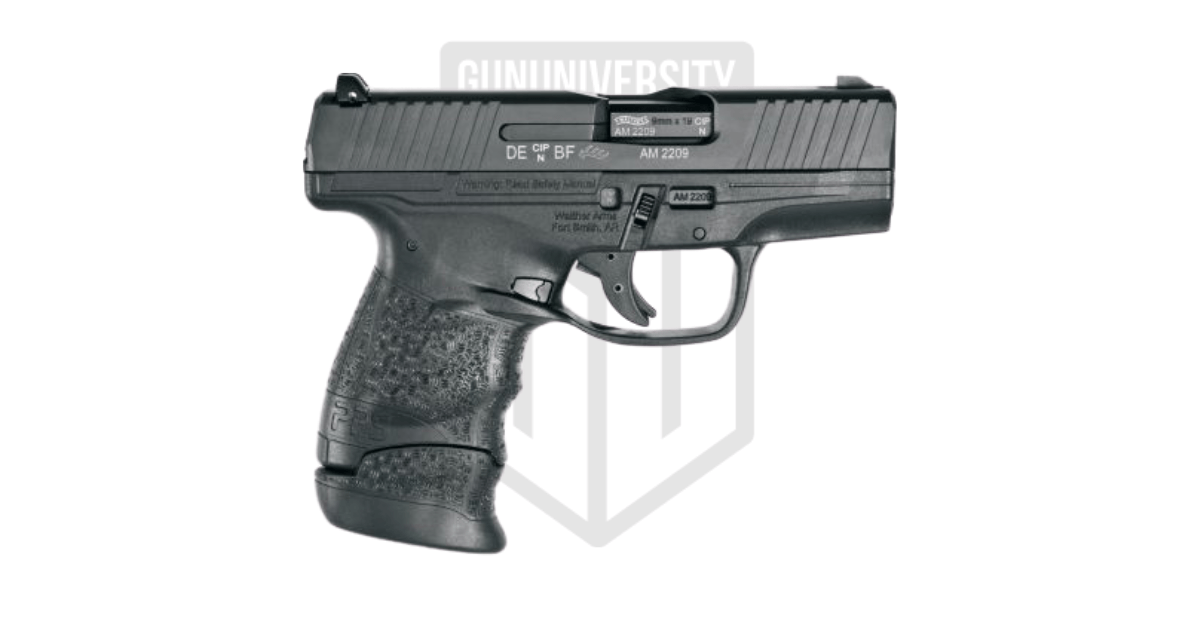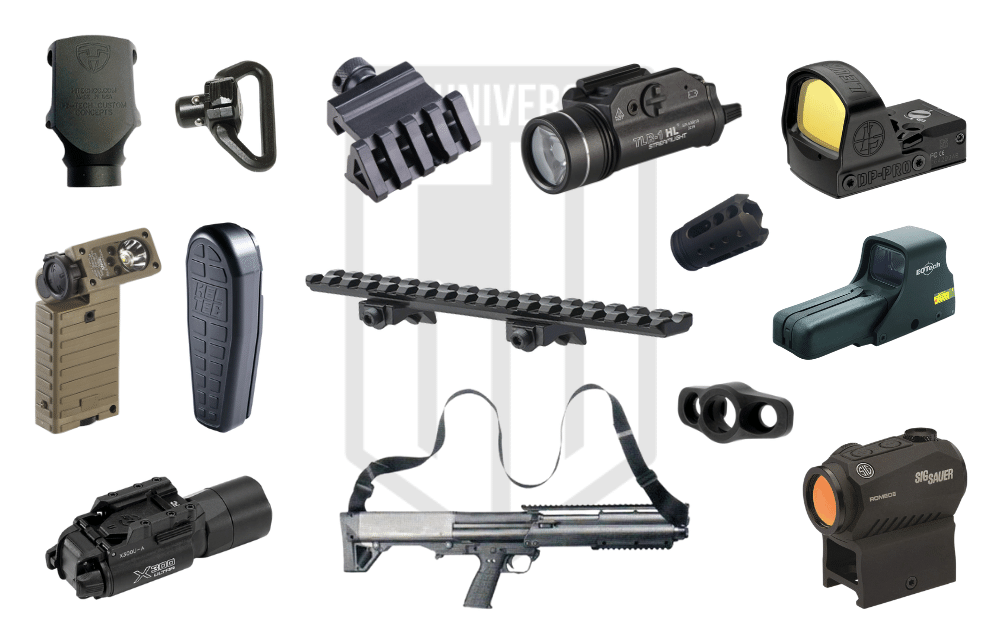Best Sig P320 Red Dots: The Definitive Guide
The SIG P320 continues to build its momentum. SIG’s striker-fired, polymer frame pistol has seen a ton of success and a few speed bumps, but it’s grown to be quite the family of pistols. The P320 series won the Army’s modular handgun contest and has become the M17 and M18 handguns. Not only is this the first general issues polymer frame sidearm, but it’s also the first to come to the military that is optics ready.
The red dot market is massive and, years ago, became quite popular with handguns. Over time we’ve seen what started as a trend grow into a mainstay of handguns. The P320 was perfectly positioned to capture this section of the market and embraced red dots fairly early. Today we are going to look at what it takes to add a red dot to your SIG p320, as well as the multitude of options on the market to outfit your SIG with a red dot.
Why Use A Red Dot On Handgun?
Even today, red dots on handguns seem to draw some ire. There is a distrust in technology that permeates the gun world. A lot of people don’t seem to realize that a high-quality red dot is extremely well-made and is quite durable. They can take some serious abuse and not break or fail.
The benefits are numerous. A handgun red dot makes every aspect of shooting easier. With a red dot, you can shoot further, shoot more accurately, and shoot faster. Admittedly it takes practice to build skill with a red dot-equipped handgun, but that practice is well worth the trade-off.
With just iron sights, I can barely ring steel at fifty yards. With a red dot, I can keep a gong moving and ringing at 50 yards without much effort. It doesn’t help you build skills. It amplifies the skills you already have.
Available P320 Factory Optic Cuts
SIG did hit a few roadblocks with the P320, and one of those was producing a variety of guns with different optics cuts. There are currently three different cuts you can find on SIG p320 handguns. These are the factory-produced optic cuts.
P320 RX Cut – The RX cut was the first and now discontinued optic cut for P320 guns. This was an optic’s speed bump. This odd cut only properly fits the ROMEO1 and will not properly fit other optics. This cut is only compatible with that optic, and even the newer ROMEO1PRO is not compatible with the RX cut.
Pro Cut Slide – The Pro-Cut replaced the RX cut. The Pro-Cut is a much better choice than the RX Cut. These new optics cut works with the new SIG optics, as well as the Leupold Delta Point Pro and Trijicon footprints. However, due to spatial differences between some optics with the RMR footprint, you may need a filler plate.
The optic will attach without a filler plate, but the filler plate will help ensure a tight and proper fit and will ensure the optic remains completely in place for however many thousands of rounds you are sending downrange in the future.
M17/M18 Series – SIG’s P320 was adopted as the military’s new handgun. That handgun had to be built to some very specific specifications, and one of those specifications was compatibility with the Leupold Delta Point Pro. They released what’s essentially a clone of the M17 and M18 series to the gun-buying public.
These guns come cut for the Leupold Delta Point Pro and not the standard Pro Cut, so keep that in mind if you want to take the M17/M18 route.
Custom Cut Slides – Of course, there is another option. You can send a blank P320 slide to a company specializing in optic cuts and have it cut for whatever you want. That’s the old-school route, but it’s efficient, especially if you already have a gun. It’s cheaper than buying a new slide, for sure.
Authors Best Sig P320 Red Dot Sights
Of course there are many red dot sights on the market that will work on a P320, but these are the ones we think are the very best for you to consider.
Click the headings to jump to the review section for each red dot or just scroll through the entire article.
Our Best Sig P320 Red Dot
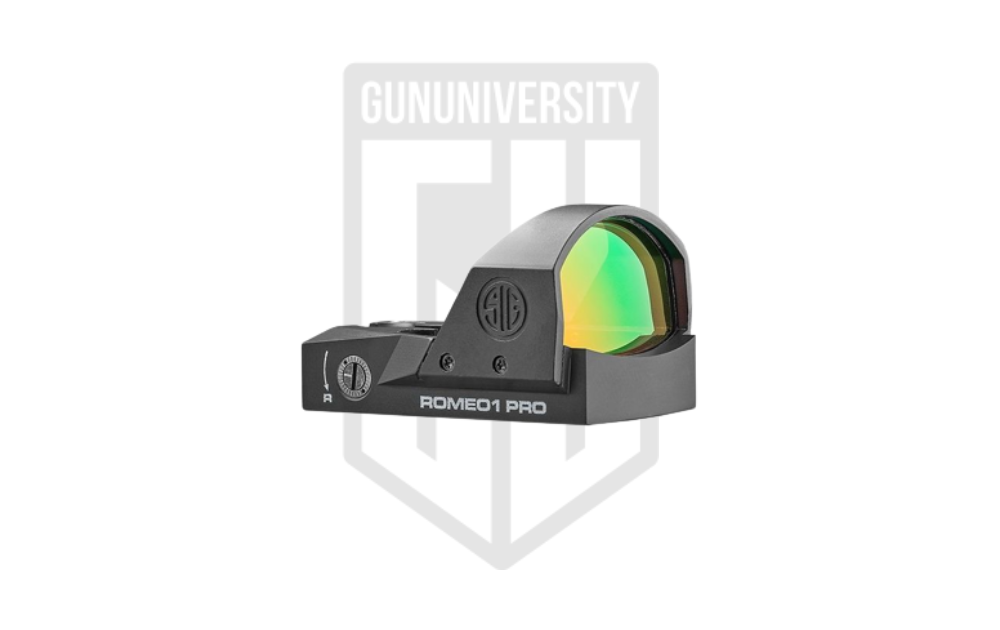 |
| Check Price | |
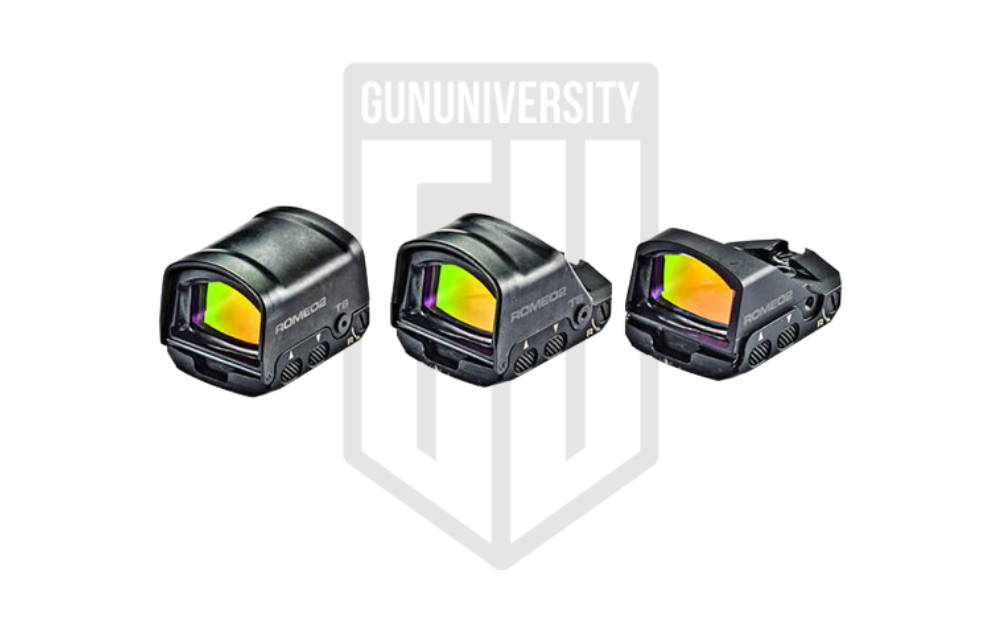 |
| Check Price | |
| Check Price | ||
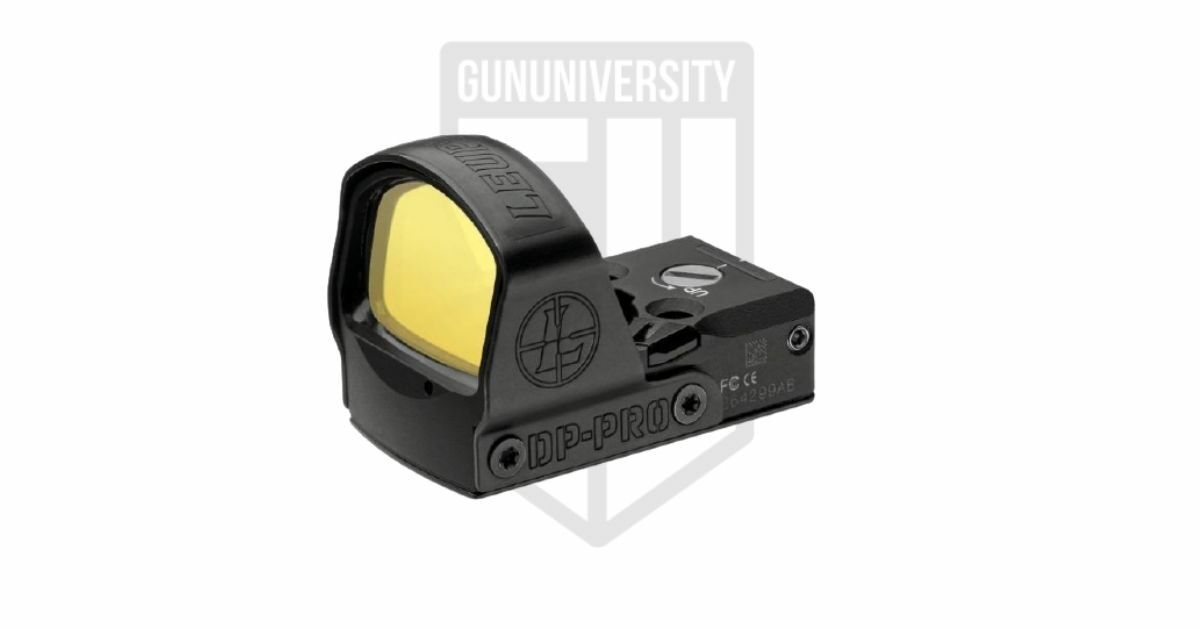 |
| Check Price | |
 |
| Check Price | |
 |
| Check Price | |
 |
| Check Price |
Best Sig P320 Red Dot Specs
| Red Dot | Reticle | Weight | Length | Height | Width |
|---|---|---|---|---|---|
| 3 or 6 MOA Dot | 1 oz | 1.83 in | 1.07 in | 1.24 in | |
| Multi-Reticle | 2.1 oz | 1.84 in | 1.12 in | 1.32 in | |
| 3.25 or 6.5 MOA Dot | 1.2 oz | 1.8 in | 1 in | 1.2 in | |
| 2.5 MOA Dot | 1.95 oz | 1.82 in | 1.3 in | 1.3 in | |
| Multi-Reticle | 1.72 oz | 1.61 in | 1.35 in | 1.21 in | |
| 2 MOA Dot | 1.5 oz | 1.78 in | 1.15 in | 1.15 in | |
| 3 or 6 MOA Dot | 1.4 oz | 1.9 in | 1 in | 1.2 in |
Here Are The Best Sig P320 Red Dots
Our favorite red dot sights for the Sig P320 are listed below.
Reviews For The Best Sig P320 Red Dots
In this review section we will break down what we like about each of the optics. We think you will find a perfect optic for you and your P320 in your price range. Read on to learn more.
SIG ROMEO1PRO Review
SIG ROMEO1PRO
- Reticle 3 or 6 MOA Dot
- Weight 1 oz
- Length 1.83 in
- Height 1.07 in
- Width 1.24 in
A SIG optic for a SIG pistol! Well, yeah, SIG says they are a total systems provider. They make the handgun, they make the light, and they make the optic. The SIG ROMEO1PRO offers a unique option that offers you a number of different features you don’t see elsewhere. The Pro model of the old ROMEO1 differs in durability and battery life improvements.
The older ROMEO1 was fine but not great. The ROMEO1PRO is great and offers 20K hours of battery life, increased durability, and even the option of a metal shroud to outfit the optic for increased durability. Additionally, the ROMEO1PRO features a massive window. Larger than most other red dots, and a large window makes a dot easier to find.
The ROMEO1PRO comes with MOTAC technology, which is a fancy way to say shake awake. If the optic sits still for an extended period of time, it automatically shuts off. When movement is sensed, it springs right back to life. The view through the lens is very clear, with a familiar blue tint.
The downside to me is twofold. The buttons are uber small and annoying so. Second, the metal shroud improves durability, but without it, the optic isn’t quite on par with the old standards like the Trijicon RMR. It’s not fragile, but it bears mentioning.
If that doesn’t scare you off, the SIG ROMEO1PRO is a very affordable, feature-filled optic for your SIG P320. Heck, it’s my optic of choice on my P320 Pro Cut slide.
SIG ROMEO1PRO Pros and Cons
- Affordable
- Huge Window
- MOTAC design
- Terrible buttons
-
$349.49
-
$429.99
#2 Sig Sauer Romeo 2
Sig Sauer Romeo 2
A red dot sight that can be either open or closed emitter from Sig Sauer
SIG ROMEO2 Review
SIG ROMEO2
- Reticle Multi-Reticle
- Weight 2.1 oz
- Length 1.84 in
- Height 1.12 in
- Width 1.32 in
We’ll go ahead and get the other SIG optic on the list done with. Not only is the SIG ROMEO2 great for the SIG P320, but it’s a novel design worth mentioning. Optics come in either open or enclosed emitters for handguns. With that in mind, the ROMEO2 is both an enclosed optic and can be an enclosed optic. It can be fully enclosed, fully open, or utilize an installed guard for superior durability.
This is the only optic I know of that offers this capability. You can go bulky but 100% reliable with the enclosed design or the lighter, sleeker, open emitter style. The ROMEO2 addresses my button complaints with ROMEO1PRo and provides two nice, big buttons for easy access to your controls.
Unlike other enclosed designs, this optic can be directly mounted to the slide instead of attaching a plate followed by the optic. Direct mounting to the slide provides the most stable, reliable, and even low-profile means of attaching the optic to the gun.
SIG produces the ROMEO2 in a few configurations with a multi-reticle design. The Circle/Dot model is my favorite, with the ability to cycle through three different reticles. The ROMEO2 uses an interesting magnetic technology that will shut the optic off when used with a compatible holster. Heck, the ROMEO2 even has a built-in rear night sight.
The ROMEO2 is the most advanced handgun red dot sight on the market. The downside is going to be that high price point! Its MSRP is higher than the cost of my P320.
SIG ROMEO2 Pros and Cons
- Novel Enclosed Design
- Huge Controls
- MAGNETAC and D.A.R.C. technology
- Expensive
-
$699.99
-
$699.99
-
$699.99
Trijicon RMR Review
Trijicon RMR
- Reticle 3.25 or 6.5 MOA Dot
- Weight 1.2 oz
- Length 1.8 in
- Height 1 in
- Width 1.2 in
SIG made a smart decision with the Pro Cut slides and allowed them to mount the Trijicon RMR. The RMR Type 2 specifically is the original pistol red dot optic. It made the idea of a defensive and duty pistol red dot a possibility. The RMR certainly has a place on our list.
Although let’s get the bad out of the way. To work with the Pro Cut slide, you’ll need a filler plate. Without it, you might run into issues with the optic fitting just right. CHPWS makes a simple and affordable filler plate to make it easy to attach the RMR and similar-sized optics.
With that out of the way, we can talk about the RMR. The Trijicon RMR is incredibly robust and crazy durable. It’s made to last long periods of abuse. It can take an absolute beating, and just keep working. It’s the choice of SOCOM for a reason.
In the center of the square window sits a very crisp and easy-to-see dot. Trijicon makes the RMR with a variety of dot sizes, and the 3.25 MOA model has always been good for me. There are also options for larger dots, and that’s entirely up to you.
The RMR features the biggest buttons in the game. These huge buttons made the optic easy to adjust, and you can change brightness on the fly with your support hand thumb without even breaking your sight picture. If the big buttons make you nervous, you can lock them out to ensure they don’t accidentally get brushed.
Besides the need for a plate, the most annoying thing about the RMR is the bottom-loaded battery. You have to remove the optic and then re-zero the optic when you swap the batteries. Luckily, you only have to do that every four years or so. When you want the toughest optic possible, you want the RMR.
Trijicon RMR Pros and Cons
- Extremely Durable
- Proven performance
- Great Crisp Dot
- Bottom Mounted Battery
-
$437.06
-
$459.99
-
$469.99
Leupold Deltapoint Pro Review
Leupold Deltapoint Pro
- Reticle 2.5 MOA Dot
- Weight 1.95 oz
- Length 1.82 in
- Height 1.3 in
- Width 1.3 in
When the P320 was adopted as the M17 and M18 series of handguns, the SIG P320 was cemented into the history books. SIG wisely released the P320 as the M17 and M18 series of P320s for those who want what the military has. This includes the optic cut. The military wanted the Leupold Deltapoint Pro as their preferred optic.
If you are rocking and rolling with an M17 or M18, then the Delta Point Pro can complete the package. Leupold is well-known as an American optic manufacturer. They make mostly variable optics, but the DPP was a departure. What makes the Delta Point Pro different is that the window is massive.
It’s a big beastly optic designed more for duty and less for concealed carry. The big window gives you an advantage when it comes to finding the dot. Big windows are more forgiving to less perfect draw and presentations. It’s also easy to follow the dot and track the dot for shot after shot with the bigger window.
Leupold makes a few different dot sizes that fall between 2.5 to 6 MOA. The DPP is also modular. You can attach a set of rear sights to the optic for use with your handgun. While the optic is huge, it’s not super heavy. At only two ounces, the DPP isn’t a big beastly thing that becomes a boat anchor.
The downside is the power button is placed right behind the lenses. It’s tucked in there and difficult to press and use on the fly. It takes a long hold to reverse the direction of adjustment as well. Admittedly the button is well protected. Your M17/M18 isn’t complete until it’s topped with a Leupold DPP.
Leupold Deltapoint Pro Pros and Cons
- Huge window
- Long Battery Life
- Clear Dot
- Bad Controls
-
$349.99
-
$349.99
#5 Holosun 509T
Holosun 509T
The Holosun 509T checks both the high-quality box and the affordably priced point.
Holosun 509T Review
Holosun 509T
- Reticle Multi-Reticle
- Weight 1.72 oz
- Length 1.61 in
- Height 1.35 in
- Width 1.21 in
The Holosun 509T is an interesting optic from a growing company. The 509T is the first affordable enclosed emitter red dot on the market. The T in 509T stands for titanium, which is a rugged and extremely light material. Holosun uses titanium for the red dot enclosure, and who doesn’t want something that’s both light and tough?
The Holosun 509T comes with a number of features that Holosun is known for. This includes a backup solar panel that provides some battery-free power in a pinch. We get shake awake to kill the optic when it’s left motionless and springs to life when it’s moved. There is a multi-reticle function that offers you a 32 MOA circle and 2 MOA dot or just a plain old 2 MOA dot.
The enclosed emitter ensures water, dirt, snow, and the crud of life can’t get between your lens and the red dot. It ensures total reliability in the worst conditions. The Holosun 509T chugs through the world with a resistance to shock and water. On the P320, it works best with the Pro Cut because Holosun wisely went with the Trijicon RMR footprint.
The downside is that it is going to sit a little high on your gun. Higher than most optics, and that’s an issue most will have with enclosed emitter optics. The Holosun 509T will need something like the C&H optic plate to make it fit and fit well. That’s not a huge problem but bears noting.
Holosun 509T Pros and Cons
- Unbeatable Reliability
- Solar Backup
- Multi Reticles
- Sits High
- Requires a Mounting Plate
-
$429.99
-
$429.99
-
$429.99
Holosun 407C Review
Holosun 407C
- Reticle 2 MOA Dot
- Weight 1.5 oz
- Length 1.78 in
- Height 1.15 in
- Width 1.15 in
Budgets are strict, and guns and ammo are expensive. If you are looking to save a little money, then the Holosun 407C might fit the bill. It’s one of the most affordable optics out there and still offers great durability, precision, clarity, and usefulness as a handgun red dot optic. To simplify things, the 407C does use the Trijicon RMR footprint. You’ll need the filler plate, but you can make it work.
The Holosun 407C is simple but still packs some of Holosun’s best-known features. It has a solar backup, as well as Shake Awake technology, and ultra-bright LED. The Holosun 407C comes with a single reticle, and it’s a 2 MOA dot. The 407C also comes with a side battery tray for total convenience.
Once mounted, you get a clear and consistently nice view through the lens with a slight blue tint to it. For a budget-friendly optic, it’s fairly nice. It’s not an optic that will leave you impressed, but it will perform when it needs to. You can get all the advantages of a red dot at a lower price. It’s durable enough for defensive use and tough enough to last.
Holosun 407C Pros and Cons
- Affordable
- Easy to Use
- Solar Backup
- Simplistic Feature Set
-
$244.99
-
$244.99
-
$259.99
#7 EOTech EFLX
EOTech EFLX
Mini Reflex Red Dot Sight
Eotech EFLX Review
Eotech EFLX
- Reticle 3 or 6 MOA Dot
- Weight 1.4 oz
- Length 1.9 in
- Height 1.1 in
- Width 1.2 in
Eotech surprised everyone early this year with the EFLX. Eotech is known for its holographic optics, but the EFLX is a mini red dot designed specifically for handguns. The EFLX uses the Delta Point Pro footprint to make mounting to your favorite SIG simple. The EFLX is always fairly affordable at less than 400 dollars. It’s a nice, unexpected surprise.
The EFLX comes in either 3 or 6 MOA, and for your SIG, either will work. Eotech is known for its durable, duty-ready optics and the EFLX keeps up that reputation. It’s made from aluminum, with everything properly sealed to resist water and moisture in general. Much like the Delta Point Pro, the EFLX features a nice wide window, but it’s not quite the 80-inch TV screen the DPP provides.
The EFLX comes with a crystal clear window. Eotech did a fantastic job with their glass. There isn’t any noticeable tint of distortion. It’s an HD view through a mini optic. The housing around the glass is minimalist, so you can have that heads-up display field of view.
We get some very user-friendly controls and a design that implements a top-loading battery and easy-to-press side buttons. The buttons are tactile and easy to press when necessary but hard to press accidentally. The Eotech EFLX is an impressive first outing for Eotech and a solid option for the P320.
Eotech EFLX Pros and Cons
- Great Glass
- Delta Point Pro Footprint
- Rugged Design
- Profile Hangs Over the Slide
-
$369.00
-
$369.00
-
$369.00
The World of Red Dot Optics: Buyers Guide
I want you to leave this article with a better understanding of not just SIG P320 red dots but of red dots on handguns as a whole. This way, when you get out into the world of red dots and handguns, you can do your own research with a more informed opinion. Here are a few basic things you should know before you start shopping.
Type of Red Dots
Modern handgun red dots are divided into two categories, enclosed and exposed emitters. Both have their pros and cons, and it’s worth knowing before you dive into either.
Exposed Emitter
Open emitter optics are the standard and the most common form of handgun red dot. Red dots are simple. An LED emitter shoots your reticle forward, where it hits a piece of glass and is then reflected for the shooter to see. With an open optic, it’s one piece of glass, and the emitter sits behind it, but it is open to the world.
An exposed emitter’s main downside is that anything can get between the emitter and glass, which will disrupt your reticle. This sounds crazy unreliable, but admittedly it’s a fairly rare occurrence. What can happen is rain, dirt, snow, and other debris can magically find their way between the two, especially if carried openly or as a duty handgun.
The upside is a lighter, smaller optic as well as a ton more options. Since there is only one piece of glass to look through, these optics tend to have greater clarity. For concealed carry, they tend to be lower profile and easier to conceal with less bulk overall.
Enclosed
Enclosed emitters are somewhat new to the market. Aimpoint started the party, but Holosun and Steiner quickly joined it. These are pistol-sized optics but feature an enclosed emitter with two pieces of glass and a hood. This results in an optic that cannot be affected by the weather or debris. Nothing can get stuck between the emitter and the lens.
This increases reliability and is especially handy on guns being carried openly. This could be a duty gun or an open carry piece. With the P320 being in 10mm these days, it could be a hunting pistol. That’s where enclosed red dots shine.
The downside to these optics is the greater complication in mounting them. They require a plate to mount to. They are also heavier and generally larger. They also tend to sit higher than most red dots. This can make concealment challenging. Learning to find the dot can be a little trickier as well, but that is easily fixed with some training.
Dot Size
When shopping for red dots, you’ll start running a number and then the acronym MOA. MOA stands for minute of angle, and it’s used to describe the dot’s size. A minute of angle is roughly 1 inch at 100 yards. If a red dot is described as having a 3.25 MOA reticle, that means the dot will cover approximately 3.25 inches of the target at 100 yards.
The larger the number, the larger the dot. The most common red dot reticle for handguns is between 2 and 3 MOA. However, that doesn’t mean the dot can’t be bigger. On handguns, a bigger dot can be quicker and easier to see.
Smaller dots like 2 MOA tend to be a little more precise, but it’s unlikely that you’ll be shooting at ranges long enough for it to matter with a handgun. Even so, it’s tough to find a dot that’s really too small, especially when you become more accustomed to a red dot.
Beginners might find a bigger dot easier to see and quicker to see as well. It’s unlikely to be too big and to cover too much of a target at handgun ranges. It really becomes a personal preference at the end of the day. What matters more than size is how bright the dot can become. It needs to be bright to be seen in the brightest part of the day.
Dot Color
Red dot seems self-explanatory, it’s a red dot, but it’s not that simple. Red dot is a generic term at this point that is essentially a term applied to nearly any reflex sight. Your red dot doesn’t have to have a red dot. In fact, it can have a green dot! Dot color is another preference you’ll have to take into consideration.
Red
Red dots are the most popular reticle color. Humans can see red quite easily, and it catches the eye. Red dots tend to have a longer battery life and be more battery sipping than other colors. The color red doesn’t often appear in nature, so it tends to contrast well against the world and is hard to lose sight of. Red dots show up under all forms of night vision as long as the dot is dim enough to be NV compatible.
Green
As we’ve improved battery life and efficiency, other colors have become popular. Green, for example, has become a popular choice and alternative to red. Green dots don’t have the same battery life as red dot sights, but it’s still considerable. Green dots can be brighter than red dots, and green as a color is easier to see for human eyes. They tend to be more relaxing to look at and will cause less strain.
Green dots will work with most night vision units. If the unit uses ANVIS lenses, then the green dot will not appear visible. Green dots due tend to work better for shooters with astigmatism. However, green does pop up quite a bit in nature and could wash out the dot.
Amber/Gold
Amber and gold are other colors that snuck into the catalogs of a few companies. These provide an interesting option if you like being a little different. These dots can be seen by people with color blindness more efficiently, and neither color tends to appear often in nature. These tend to have the worst battery life of optics, and the dots can wash out when faced with bright light.
Reticle Design
I know what you’re thinking, a red dot isn’t always red, but it’s at least always a dot, right? No, sadly, it’s not always a dot. There are a few optics that are still considered red dots that use more complicated or varied reticles. There are a few common reticle choices you should consider.
First, Holosun has made the circle and dot a mainstay of their catalog. The 32 MOA circle combined with the 2 MOA dot makes a nice big reticle that can be seen quickly but efficiently and used easily. It’s great on small guns and for fast close-range shooting. It’s also much easier to see if you suffer from astigmatism.
Trijicon also produces a variant of the RMR with a big 12.9 MOA triangle. This triangle is quite larger and easy to see, and it also works fairly well for shooters with astigmatism. It’s not perfect, but better than a red dot and less likely to ‘star’ on the shooter.
Primary Arms and Holosun have also teamed up on a few optics, and those optics often feature a slight chevron-style reticle. It’s less triangular than the Trijicon model. It’s big and easy to see but also fairly thin and doesn’t obscure a target too much.
Reticle design is another personal choice. It’s easy to adapt to any reticle, but maybe your eyes like something different than the dot.
Battery Location
Handgun-sized red dots don’t exactly have a ton of room for batteries. Most used a coin-type battery like a 2032. Where the battery is located and how it is accessed can make a bit of a difference when it comes to using a handgun red dot. Bottom-mounted batteries can often be a pain. They position the battery so that the red dot has to be removed to access it and swap it. This then requires the dot to be reattached and then re-zeroed.
These are becoming less and less popular over time. Another option is a side-loading battery with a tray that slides outward. These tend to be ergonomic and easy to use. No need to dismount your battery. You just need to be cautious because the battery tray tends to be easy to break.
Finally, we have top loading. In top-loading designs, the battery sits behind the lens, and a cover is removed from the battery for easy access. No need to remove the optic from the gun. It’s fairly convenient and easy to access.
Co-witnessing
Co-wtinessing with iron sights can be a handy piece of insurance in case your optic dies or breaks. Iron sights sit within your view and can be used through the optic. Because red dots sit higher than standard iron sights, you’ll need taller sights.
These are traditionally called suppressor height sights. If your weapon is being sued for defense or duty, it’s likely a wise decision. Luckily the P320 platform is popular, and these sights are easy to find. SIG even produces certain optic-ready models with these sights preinstalled.
Optically Enhanced
The P320 is a very modern and modular handgun that is making serious waves in the handgun world. Adding an optic is the next step in taking your P320 into the future of handguns. Hopefully, you have a good idea of what you want, what works, and what to avoid if you have any questions feel free to ask below!
Recent Posts
December 15, 2025
December 15, 2025
December 12, 2025
December 12, 2025




